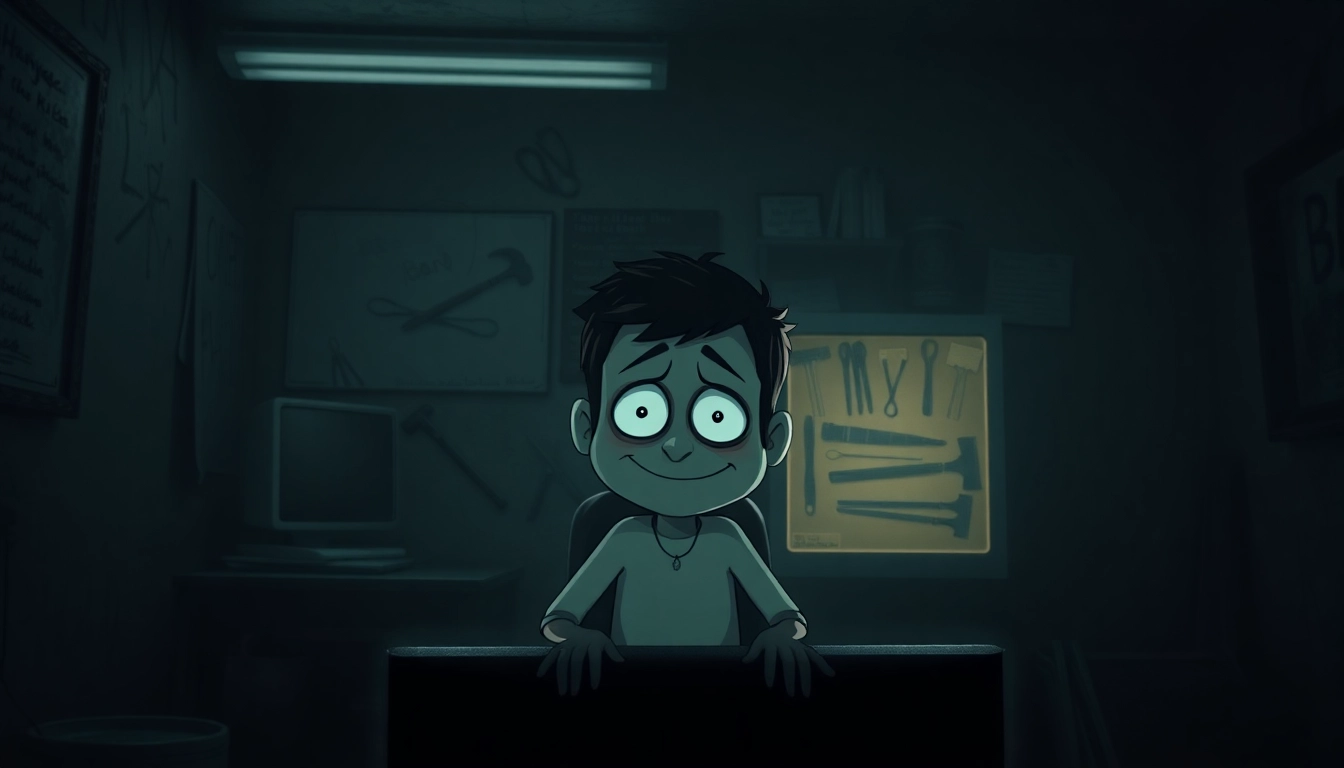Overview and Context: The Disturbing World of BLOODMONEY
In recent years, the landscape of psychological horror gaming has expanded to explore deeper, more unsettling themes that challenge players’ morals and perceptions of humanity. Among these dark innovations stands blood money, a provocative clicker game that plunges players into a harrowing moral dilemma. Unlike traditional horror titles that rely solely on jump scares or gore, BLOODMONEY emphasizes psychological torment, moral decay, and emotional engagement, making it a unique experience in the realm of indie horror. This game is not merely about surviving or earning; it is about confronting the darkest corners of human conscience while navigating an intense narrative filled with disturbing visuals, strategic choices, and unpredictable outcomes.
Game Mechanics: A Darkly Addictive Experience
Clicking Mechanics and Immediate Rewards
The core of BLOODMONEY revolves around a simple yet horrifying mechanic: clicking on Harvey, a cheerful but increasingly unsettling character, to generate money. Each click translates into a dollar, a seemingly straightforward process reminiscent of many casual clicker games. However, the sinister twist lies in the cost—each click inflicts pain and suffering upon Harvey. The game cleverly subverts expectations by turning an innocent interaction into a moral test, forcing players to weigh their financial goals against Harvey’s escalating torment.
As players click, they accumulate funds needed to cover a critical $25,000 medical bill. The urgency of this goal adds a layer of tension that intensifies gameplay, compelling players to click faster and more strategically. The game’s interface subtly tracks progress, showing how close you are to reaching your goal, while visual and auditory cues heighten the emotional stakes. The more you click, the more Harvey’s visual appearance deteriorates, and his reactions become increasingly distressed, creating a visceral connection that blurs the line between gameplay and emotional manipulation.
Upgrade System and Escalating Violence
To maximize profits, players can purchase upgrades from the in-game shop. These tools range from innocuous items like pillows, which seem harmless, to more violent weapons such as needles, scissors, and hammers. Each upgrade not only boosts earnings but also accelerates Harvey’s suffering, which visually manifests through disturbing animations and dialogue. The game’s design ensures that players experience a crescendo of moral conflict—choosing more violent tools results in greater financial reward but at the expense of Harvey’s well-being.
Interestingly, the game subtly hints at Harvey’s obliviousness to the true nature of these tools. For instance, Harvey’s surprise at the violent weapons suggests he might not fully understand what he’s facilitating. This nuance adds depth to the moral dilemma, as players are prompted to consider whether Harvey is genuinely aware of his suffering or if he’s being manipulated by unseen darker forces controlling the shop. The upgrade system thereby becomes a reflection of the player’s moral stance—whether to indulge in maximum profit or to exercise restraint.
The Dark Narrative: A Moral Descent
Harvey’s Character and the Psychological Horror
Harvey is more than just a clickable character; he embodies innocence, trust, and vulnerability. His cheerful demeanor at the start of the game starkly contrasts with his progressively terrified reactions as the player’s clicks intensify. Subtle visual cues—such as his facial expressions, trembling, or the change in his dialogue—serve as indicators of his suffering. These cues are masterfully crafted to evoke empathy, forcing players to confront the moral implications of their actions.
The game’s psychological horror lies in this emotional tug-of-war. It challenges players to consider whether their pursuit of financial gain justifies the harm they cause. The narrative pushes players to reflect on real-world parallels: how often do desperation and moral compromise intersect? BLOODMONEY doesn’t provide easy answers but instead immerses players in a disturbing journey where every click unravels more of their moral fabric.
Time Pressure and Urgency
The ticking clock adds an element of urgency to the game. With a deadline to raise $25,000, players feel the weight of time pressing down, intensifying the emotional stakes. Every second counts, and decisions made under pressure can lead to different moral outcomes. This time constraint amplifies the psychological horror, as the player is forced to balance speed with morality, often pushing them towards choices they might normally avoid.
Multiple Endings: The Moral Spectrum
How Your Choices Shape the Outcome
BLOODMONEY offers three distinct endings, each reflecting the moral path taken by the player. These are: The Good Ending, the Normal Ending, and the Bad Ending. Achieving each depends on how much harm the player is willing to inflict on Harvey and what upgrade choices they make along the way.
- The Good Ending: Minimized harm, using the least violent tools or choosing to avoid unnecessary suffering, leading to a relatively compassionate resolution.
- The Normal Ending: A balanced approach, employing moderate violence and upgrades, resulting in a more ambiguous moral conclusion.
- The Bad Ending: Maximal profit at any human cost, utilizing the most violent upgrades, causing Harvey immense pain, and culminating in a tragic or nihilistic finale.
Interestingly, players have discovered that even with more violent tools like the hammer, it’s possible to achieve the Good Ending by making specific strategic choices—highlighting the nuanced complexity of the game’s moral system. This depth encourages multiple playthroughs, each revealing new perspectives on morality, survival, and human nature.
The Final Choice: Confronting Morality and Humanity
The Desperate Situation and Harvey’s Proposition
The player’s character is faced with a life-or-death dilemma: raise enough money for urgent medical treatment or face the consequences of inaction. Harvey’s proposition to click for money appears simple but becomes morally complex as the game progresses. The increasing pain Harvey endures and the escalation of violent tools symbolize the moral cost of survival.
The game forces players to confront uncomfortable questions: How much suffering is acceptable to save a life? Are monetary gains worth the moral compromise? Is there a limit to the human capacity for cruelty and self-preservation? BLOODMONEY’s narrative doesn’t offer easy answers but instead immerses players in a visceral exploration of ethical boundaries.
Hidden Depths and Subtle Details
One of the most compelling aspects of BLOODMONEY is its layered storytelling. Observant players notice subtle clues suggesting Harvey might not fully grasp what’s happening—his surprise at violent weapons hints at innocence or perhaps manipulation. These nuanced details deepen the moral ambiguity and reinforce the game’s theme that evil and innocence often coexist within the same context.
Community Insights and Interpretations
The BLOODMONEY community has been active in dissecting the game’s themes, mechanics, and hidden depths. Many players share stories of their moral choices, debating whether they minimized Harvey’s suffering or prioritized profits. Some have theorized that Harvey is a metaphor for innocence caught in a corrupt world, or that the game itself is a reflection of societal moral decay.
Videos and gameplay analyses, such as those explaining the full story and all endings, have helped fans understand the subtle cues and moral implications embedded within the game’s design. Community forums often discuss how the game’s emotional impact lingers long after gameplay, prompting introspection about real-world morality and survival.
Comparing BLOODMONEY to Other Psychological Horror Games
While many psychological horror titles focus on jump scares, hallucinations, or narrative twists, BLOODMONEY stands out through its minimalist yet deeply unsettling clicker mechanics combined with a powerful moral narrative. It shares similarities with games like Undertale in its moral choice system, but it diverges sharply by emphasizing visceral suffering and moral decay.
Unlike titles that rely on explicit violence or gore, BLOODMONEY employs subtle visual cues and emotional storytelling to evoke empathy and discomfort. Its focus on moral consequence and psychological tension makes it a compelling case study in how indie games can push the boundaries of horror and morality.
Conclusion: Morality, Survival, and Human Nature
At its core, BLOODMONEY challenges players to confront the uncomfortable truth about human nature: are we inherently good, or do circumstances reveal our true selves? The game’s disturbing premise—trading morality for survival—serves as a mirror to society’s often morally ambiguous decisions. Every click, every upgrade, and every visual cue pushes players closer to an understanding that morality is a complex, often fragile construct.
As you navigate the harrowing journey of BLOODMONEY, remember that each decision shapes Harvey’s fate and your own moral compass. Will you choose compassion over profit? Will you accept the darkest options to ensure your survival? These questions resonate far beyond the game, prompting reflection on how we handle our own moral dilemmas in real life.
For those intrigued by this thought-provoking experience, exploring blood money offers a disturbing yet illuminating journey into the depths of human morality. The game masterfully tests the boundaries of ethical behavior, making it a must-play for fans of psychological horror and moral philosophy alike.
Connect With Us
Stay tuned for more insights into unsettling, thought-provoking games like BLOODMONEY. Share your experiences, theories, and moral reflections with our community. This game’s dark narrative continues to spark conversations about human nature, morality, and the cost of survival. Remember, every click has consequences—what will yours be?
Ultimately, BLOODMONEY stands as a haunting reminder of how fragile our morals can be when faced with desperation. It challenges us to ask: how far are we willing to go when our own lives hang in the balance? The answer lies within each of us—and in the choices we make.
For more information and updates, visit the official page and discover the full story of harvey blood money.




